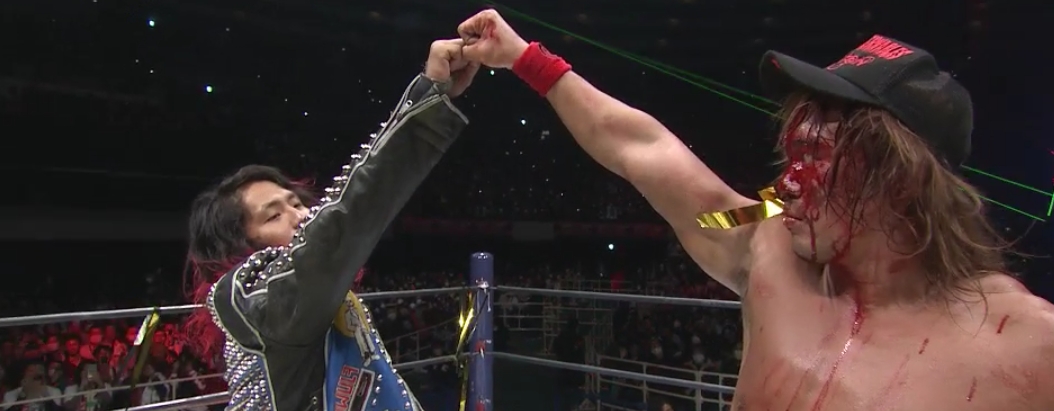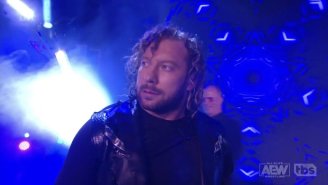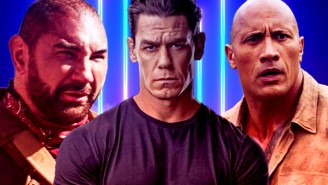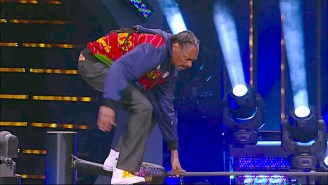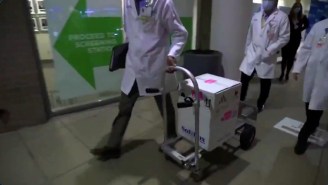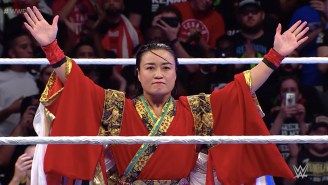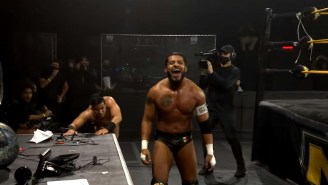Previously on NJPW: Jon Moxley brought his brand of chaos to Chaos, Shingo Takagi vowed to NEVER lose his new championship, and Zack Sabre Jr. did a tight five on Zima.
You can watch New Japan Pro Wrestling shows on their streaming service, NJPW World, which costs 999 yen (about 9 USD.)
You can keep up with With Spandex on Twitter and Facebook, follow our home site Uproxx on Twitter, and even follow me on Twitter @emilyofpratt.
Don’t forget to share this column on Facebook, Twitter, or whatever social media you use! Also, leave a comment with your thoughts on the show and/or article! All feedback is appreciated and will help us keep up the NJPW coverage.
Road Show Recap And Recommendations
In addition to a review of the New Beginning in Osaka, this is the first installment of this column’s new format that includes some recap and analysis of Road To shows, along with recommended matches, before larger shows. I did this in some earlier reviews, but now it’s the rule rather than the exception. The idea is to keep these Best and Worsts comprehensive while making them less time consuming for me. If you have any takes about the new format, please leave them in a comment! If everybody hates this and/or I feel like it’s not working, I’ll tweak the format some more.
Okay, with that out of the way, let’s go over the important stuff from the Road to the New Beginning!
[Replay ‘Road to the NEW BEGINNING Night 5’ on February 4th, 2020]
7TH MATCH: ELIMINATION MATCH @njpwShowT , @njpwyohei_k , @WillOspreay & @rainmakerXokada vs. @kmaru0923 , @ElDesperado5 , @zacksabrejr & @taichi0319!!
Watch on #njpwworld ▶︎https://t.co/CcdQ1X9P52#njpw #njnbg pic.twitter.com/VfUUHtsc4K— NJPW WORLD (@njpwworld) February 4, 2020
A highlight of the Road to the New Beginning shows is always the elimination match or two New Japan throws in there, and though I wasn’t crazy about this tour’s, I still enjoy one of the few times a year NJPW gets gimmicky. The stronger one is the main event on February 4, which is Chaos (Okada, Ospreay, Sho, and Yoh) vs. Suzukigun (Taichi, Sabre, Desperado, and Kanemaru.) It starts slow and builds to some fun eliminations. The most important one is the one that wins the match, Ospreay pinning Sabre with a Stormbreaker. This allows him to re-challenge for the RevPro title, and this time he and Sabre will wrestle for it in London on an actual RevPro show.
This explains why Ospreay didn’t win in Sapporo and seems like a smart move for Revolution Pro Wrestling. I’m not a wrestling business expert, but I’m pretty sure rewarding the hometown crowd by letting them get to actually see one of your biggest babyfaces win your most important championship for the first time rather than making them watch this happen 6,000 miles away through another company’s streaming service is a good business decision.
The main event of the February 5 show is the L.I.J. (Bushi, Hiromu, Sanada, and Naito) vs. Bullet Club (Jay White, Ishimori, ELP, Kenta) elimination match, and the best part is the BC juniors working together to avoid touching the floor. A lot of this match is about getting the crowd to boo the bad guys in a way that doesn’t do as much for the audience watching from home, but it’s not bad.
Higher highlights are everything to do with the NEVER Openweight Championship and, in an extremely rare turn of events, the NEVER Openweight 6-Man Tag Team Championship.
Road to THE NEW BEGINNING後楽園大会2日目‼️
第5試合、@510njpw & @HenareNZ🆚@Takagi__Shingo & @151012EVIL‼️
NEVER王者・鷹木とヘナーレがバチバチのどつきあいを展開‼️
登録&視聴👉https://t.co/CcdQ1XrpWA#njpwworld #njnbg #njpw pic.twitter.com/7xMPBb8sq0— NJPW WORLD (@njpwworld) February 5, 2020
The NEVER-centric tag match of Hirooki Goto and Toa Henare vs. Evil and Shingo Takagi answers the question “When will Henare get to do things?” with “Maybe soon” and is an exciting match on its own. Henare and Shingo keep the beef from their singles match last fall alive and continue to work really well together in the ring.
In this match, it’s easy to see that the NJPW dojo grad is obviously not on the level of the other guys in this match, especially Goto and Takagi. That’s not a dig on Henare though; those guys both have like a decade of experience on him and way more time to hone their hard-hitting styles. But Henare increasingly looks like he could get to where they’re at and the fact that he’s not feeds into his character arc of trying to beat all these more experienced tough guys who he intensely admires.
The biggest developments for both NEVER championships is in the February 6 main event, which is almost definitely the best NEVER Openweight 6-Man Tag Team Championship match ever. The pairs of heavyweights absolutely kill it together yet again, Ishii and Shingo confirm their singles match is going to bang, and Evil and Goto build hype for the next time they go one-on-one.
The Bushi vs. Robbie Eagles mini-feud is really good too, with most of the tension surrounding who will in the match based on Eagles having recently tapped out Bushi twice with the Ron Miller Special. Bushi figuring out how to escape the move (by cheating, but L.I.J. just gets to do that to a certain degree and mist is cool) to get the win makes the end of the match extra satisfying if you’ve been watching the build to it.
This Los Ingos vs. Chaos feud gave us some kickass, serious tag team wrestling. Yano (with Taguchi’s direction, sort of) stealing the belts takes them back to comedy match territory, but that’s not a bad thing. Evil, Shingo, and Bushi were killing it at comedy matches on the Fantastica Mania tour and Taguchi, Yano, and Cabana is a clown dream team. With some likely top-tier clownery coming up along with Ishii and Takagi trying to sliding lariat each other to hell for a second time, it looks like the NEVER title pictures might NEVER stop being this good, at least for a few more weeks.
Okay, with the Road To highlights out of the way, here’s the Best and Worst of the New Beginning in Osaka, which took place at Osaka-Jo Hall on February 9, 2020.
Best: Twilight For Monster Morning
THE NEW BEGINNING in OSAKA🏯‼️
第1試合は中西学ファイナル大阪城ホール‼️
"野人"@nobitokunが最後の大阪大会で大暴れ‼️
そして第三世代が4人が集結‼️
登録&視聴👉https://t.co/CcdQ1XrpWA#njpwworld #njnbg #njpw pic.twitter.com/5JR7kBmtCC— NJPW WORLD (@njpwworld) February 9, 2020
I thought the New Beginning in Osaka had its weaknesses along with its strengths, but was overall entertaining and easy to watch all the way through. The undercard is stronger and more interesting than on both nights in Sapporo, starting with the extra-motivated, mostly dads opening tag of Nagata, Kojima, Tenzan, and Nakanishi vs. Makabe, Honma, Taguchi, and Henare.
The Third Generation and GBH guys bring their old man A-games and Henare again turns in a performance in one of these opening matches that makes you want him not to be stuck in these opening matches much longer. The post-match stuff basically confirms that Nakanishi’s definitely going to cry at his retirement show, which means other people are probably going to cry too. (It’s me; I’m “other people.”) All in all, this was one of the better matches in the Nostalgia Opener genre.
Mostly Best: Roppongi Civil War
THE NEW BEGINNING in OSAKA🏯‼️
第2試合IWGPジュニアタッグ選手権試合‼️
王者組@njpwShowT & @njpwyohei_k 🆚 挑戦者組@ElDesperado5 & @kmaru0923‼️
挑戦者組の執拗な膝攻めにSHOの膝は限界寸前‼️
果たして勝負の行方は⁉️
登録&視聴👉https://t.co/CcdQ1XrpWA#njpwworld #njnbg #njpw pic.twitter.com/HelLksT4Mn— NJPW WORLD (@njpwworld) February 9, 2020
Roppongi 3K and El Desperado and Kanemaru have wrestled each other so many times that second on the card seems like the appropriate place for one of their matches, even if it’s for a championship. In the second match of the New Beginning in Osaka, these teams have a pretty good match again, though one that often made me feel like I remembered better versions of the spots they were doing because they’ve tangled so many times.
But they did give this match its own identity by Yoh and Desperado building the foundation for a standout Best of the Super Juniors match, Suzukigun heavily focusing on one of Sho’s legs, and Sho showing up with a new “I’m thinking about fighting Shingo Takagi again” dye job. I thought Sho’s facials and selling got too over the top at times, but this was still a pretty strong performance from him.
The IWGP Junior Heavyweight Tag Team Championship match is kind of overshadowed by the next step, after helping Yano steal the 6-Man titles, in Taguchi’s plan to cure the title fever he cut a promo about on the New Beginning tour: the reunion of the Mega Coaches to challenge Roppongi 3K. We get Taguchi speaking a surprising amount of English to get Rocky back in the game, Rocky accepting his offer by shooting a basket through his arms, and Roppongi 3K showing their serious side in response to a challenge by their seniors. With all this and how good their match in Super Junior Tag League was in mind, this is a really promising development.
Also very promising is how Sho, feeling enabled by the double championship fever that’s sweeping the company, talks about how this is finally, definitely the year he’s going for singles gold and calls out any champion watching this, but clearly just one specific champion. I’m loving the slow burn aspect of this second round of the Sho-Shingo rivalry so far; it both heightens the drama for their inevitable match and makes it feel more like Sho might actually win.
In Other Mega Powers Uniting Tag Team News
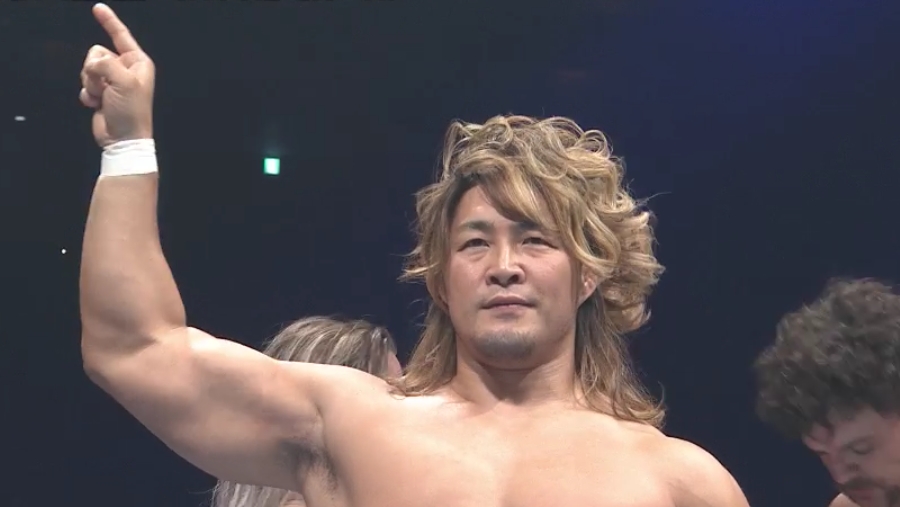
We also get a development in the other tag division that follows up on an unexpected from the New Beginning in USA tour, G.O.D. winning the IWGP Heavyweight Tag Team Championship match from FinJuice. This match in Osaka establishes that the other new players in the tag division are thankfully still hanging around, but putting the belts right back on the old champs still kills some of the momentum the division had coming out of Wrestle Kingdom.
The three possible reasons I can think of for why G.O.D. got the tag titles back after about a minute are 1) it was a change of plans that somehow had something to do with Ibushi not being able to work the tour due to getting Mallory-Weiss Syndrome (he’s fine now), 2) something to do with WrestleMania weekend 3) Ibushi and Tanahashi and FinJuice trying to get titles from G.O.D. at the same time creates competition between them that’s less friendly than the match they set up at New Year’s Dash!! originally looked like it was going to be. Right now, my guess is a combination of the second and third options.
Anyway, this eight-man tag is alright, with Tanahashi’s hair clearly the star of the show. I’ve seen it called Dolly Parton hair and pageant mom hair, and I’ll add the less good lady’s Rococo wig comparison into the mix. Somehow, it’s less confusing than the setup of what’s going on in the tag division right now.
THE NEW BEGINNING in OSAKA🏯‼️
第4試合スペシャルタッグマッチ、@rainmakerXokada & @WillOspreay 🆚 @zacksabrejr & @taichi0319‼️
鈴木軍タッグのダーティーファイトに苦しむCHAOSタッグ‼️
一体どんな展開を見せるのか⁉️
登録&視聴👉https://t.co/CcdQ1XrpWA#njpwworld #njnbg #njpw pic.twitter.com/70U3PBRZbm— NJPW WORLD (@njpwworld) February 9, 2020
After Ibushi and Tanahashi are confirmed as still a real tag team, Okada and Ospreay show they’re now a super team in the way IbuTana used to be by beating Taichi and ZSJ, another pair who could get involved in the tag division any time. The Chaos boys’ teamwork leads to them beating Dangerous Tekkers, and the finishing sequence elevates this match a few notches.
Not Everyone Is A Brawler And That’s Okay
Zack Sabre Jr. and Will Ospreay have a big match coming up and they’re displaying how heated they are about it through, among other things, by brawling in the audience. I don’t know if I’ve ever seen the NJPW house style fit a pair of rivals so poorly.
There’s a difference between having a wrestling match and having a fight, and there isn’t a one hundred percent crossover between people who are good at doing both of those things. Ospreay and ZSJ brawling reminds me of a fight I saw at about two-thirty in the morning in one of those shared living houses (basically a dorm or boarding house in which landlords squeeze about fifteen people) in Los Angeles. Tensions between two guys who bunked in the same room boiled over and Guy A, who had been on his high school wrestling team, tried to double-leg Guy B, who had grown up actually getting in fights. Guy B quickly got the better of Guy A, the fight ended with no one seriously hurt, and Guy A was a lot quieter about his wrestling skills for a while.
Ospreay and Sabre are clearly both Guy A in real life, and it seems like they should be in kayfabe too. ZSJ even basically says this in his Osaka promo on Moxley. Neither of their wrestling styles – or at least the part of their wrestling styles that made them stand out from the many other junior heavyweights of indie wrestling – looks like real fighting. As long as their matches feel like a competition or wow people enough that the audience doesn’t care that they don’t look like competitions, that works.
But when they try to insist they’re tough guys of the squared circle (whenever Sabre does a headbutt or hangs in a strike exchange too long, whenever Ospreay does his new no-sell-flex-scream pose or decides half of a match is about him now being a Brutal Striker) as well as their own unique type of wrestler, it looks like a joke. It hurts the rest of their act too because it messes with the type of suspension of disbelief the viewer has to have to take their matches seriously – and in New Japan, you’re almost always supposed to take them very seriously.
Seeing these two brawl around Korakuen Hall on the Road to shows and in Osaka and play it completely straight – and in Ospreay’s case, play it completely straight while acting the most like a Theater Kid I’ve ever seen from someone who isn’t literally a high school kid acting in community theater musicals – bugged me a lot over these past couple shows! I wish whoever’s made the decision to have Sabre and Ospreay try to act like they would actually fight each other and that this would be a cool and badass thing had made a different one that compliments them more.
Worst: This Should Have Been A ‘Loser Shaves His Beard’ Match
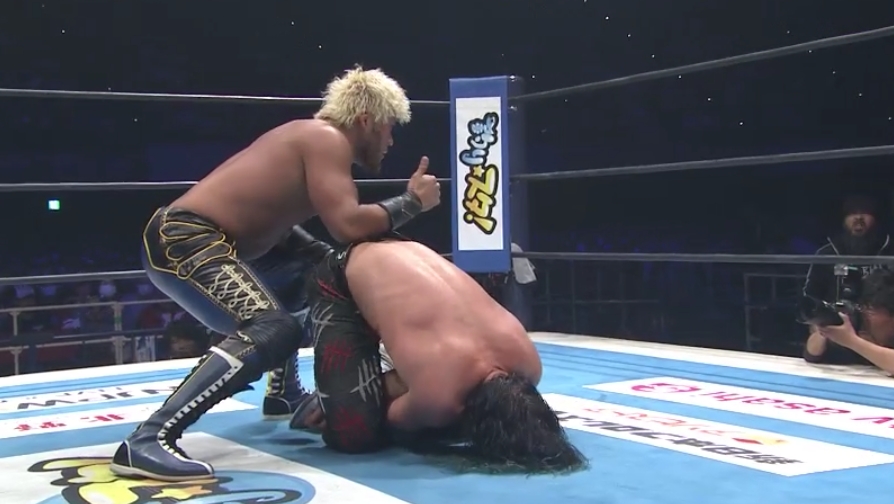
The things I can remember from Jay White vs. Sanada are:
- Sanada doing some athletic stuff at the beginning
- Jay White’s beard looking the most it’s ever looked like pubes when he was in Skull End
- Sanada putting Jay in the Paradise Lock, prompting NJPW to give us this amazing shot of Gedo and Milano’s reactions:
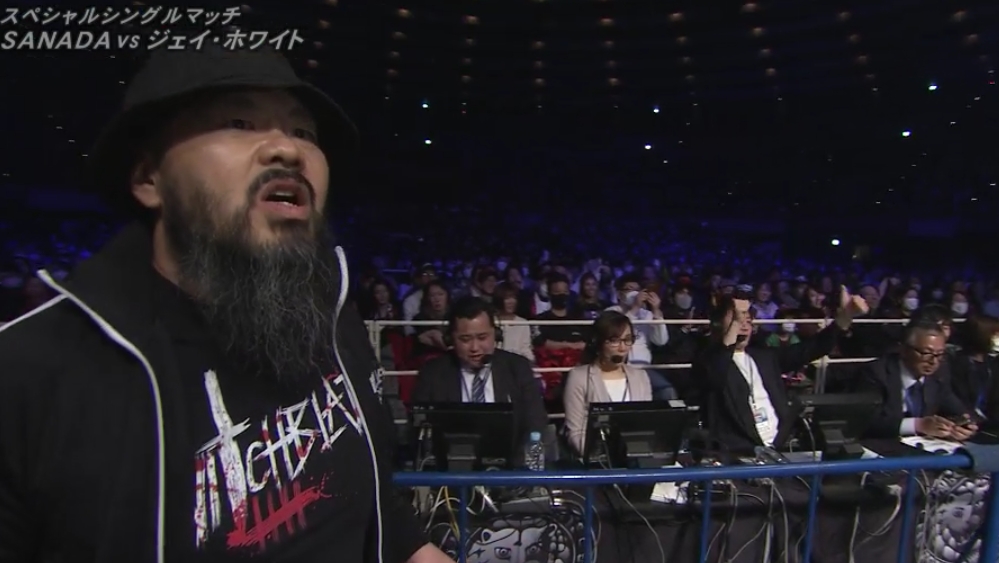
This match had no stakes (not even any clear “momentum” type ones), no compelling underlying drama, and nothing that made it stand out as a match in itself. This was just a match that happened.
Best: Please Don’t Die!
THE NEW BEGINNING in OSAKA🏯‼️
第6試合IWGPジュニアヘビー級選手権試合、@TIMEBOMB1105 🆚 @dragonlee95‼️
あの闘いから582日…二人のライバルストーリー再び動き出す‼️果たしてこの激闘を制するのはどちらだ⁉️
登録&視聴👉https://t.co/CcdQ1XrpWA#njpwworld #njnbg #njpw pic.twitter.com/7f9nBO0BeQ— NJPW WORLD (@njpwworld) February 9, 2020
When Hiromu Takahashi first came back from injury, he made fun of people asking if he’d change his wrestling style and maniacally took some flat back bumps. Takahashi vs. Ryu Lee for the IWGP Junior Heavyweight Championship in Osaka is the version of that segment that includes most of the actual crazy bumps he’s known for, for around twenty minutes.
At first, it seems like this might be the safer version of a Hiromu vs. Lee match, opening with those fast German suplexes followed by about two minutes of each man trying to chop the other’s pecs off. It’s quality wrestling that brings back the memories of their past matches in a really fun way.
Then they decide to bring back those memories in an anxiety-inducing way, which was clearly intentional on Hiromu and Lee’s part. Their series of crazy spots is strung together by all of them seeming extra dangerous in a post-injury world. The scariest moment is when they first go for the actual move that injured Hiromu, and when he later definitively counters it with a Canadian Destroyer, there’s a sense of relief. When Hiromu comes out of this match victorious, it feels like he’s finally, fully back as the wrestler he used to be with just a little more considerate of his neck.
>:-P
THE NEW BEGINNING in OSAKA🏯‼️
第7試合IWGP USヘビー級選手権試合、@JonMoxley 🆚 @suzuki_D_minoru‼️狂犬🆚プロレス王‼️
両者一歩も譲らない凄まじいどつきあい‼️
この激闘制するのはどちらだ⁉️
登録&視聴👉https://t.co/CcdQ1XrpWA#njpwworld #njnbg #njpw pic.twitter.com/1zGKzEGzx1— NJPW WORLD (@njpwworld) February 9, 2020
As the hype video for their U.S. title match displays scored by dramatic piano music, Minoru Suzuki and Jon Moxley earned their reputations as violent wrestlers in very different ways. While their backgrounds have little in common, they share charisma and the willingness to ham it up and have a good time in a high profile feud, which is what made the build to their Osaka match so fun to watch.
Their bout for the United States Championship started with the same tone as their interactions in Sapporo, and I thought it worked great. The opening with the chair fight on the entrance ramp, the initial barricade-assisted fighting in the crowd, and the sequences surrounding the table are all really fun. The part where Suzuki and Mox both hit themselves in the head with pieces of table took this match over the shark for me, though. The tone and the length of the match and the performances stopped meshing.
By the end, Suzuki’s seemed like self-parody, without being as clever or funny like his intentional self-parody in DDT several years ago. It’s Minoru Suzuki boiled down to wacky faces and an evil laugh, and it turns out you need all the other aspects of Minoru Suzuki to make those wacky faces and evil laugh moments work, even in a jokey match like this one.
Best/Worst: 2 Belts V1
THE NEW BEGINNING in OSAKA🏯‼️
第8試合IWGPヘビー級・IWGPインターコンチネンタル ダブル選手権試合、二冠王者@s_d_naito 🆚 挑戦者@KENTAG2S ‼️
両者共にペースをにぎらせない試合が続く‼️一体どんな展開を見せるのか⁉️
登録&視聴👉https://t.co/CcdQ1XrpWA#njpwworld #njnbg #njpw pic.twitter.com/o1br7wPR0g— NJPW WORLD (@njpwworld) February 9, 2020
Tetsuya Naito’s first defense of both the IWGP Heavyweight and Intercontinental Championships is a match that highlights his strengths and exposes both the pros and cons of his challenger. In 2020, Kenta is fantastic at the non-wrestling part of wrestling. His promos are clever and must-watch, his character work is top-notch, and he’s so good at getting the crowd laughing as well as booing that he now has people cheering for him along with some who seem ready to genuinely fight him. Both how Kenta performed and how the Kenta character was used built maximum hype for this match.
Unfortunately, 2020 Kenta is hit or miss when it comes to having the wrestling matches part of wrestling. When things look competitive between him and Naito, it’s exciting, but the parts of the match Kenta controls drag. Kenta gets fans invested in promos and on Twitter, but his Game Over enabled by a ref distraction in this match barely stresses out the crowd at all.
But the final stretch of this match picks up so much that thinking back on the New Beginning in Osaka main event, the boring part of it is overshadowed. Naito looks like he gets shoot busted open on the turnbuckle pad and starts bleeding disgustingly and it rules. Naito is incredible at bleeding; so much always seems to gush out of him and the way it covers his face under his hair with his hound dog eyes shining out makes a visual that’s the exact combination of gross and cartoony on which pro wrestling is founded. The wrestling speeds up around this time too and the blood makes everything seem even more intense until Naito hits Destino for the win.
With two strong first defenses under their belts (or in Naito’s case, at least strong for him), Naito sets up an Anniversary Show main event that almost seems too good to be true, and the traditional Heavyweight vs. Junior Heavyweight Champion match is going to be Naito vs. Hiromu. It’s two great wrestlers with amazing chemistry that’s only been displayed as friends and tag partners so far, backed by the weight of their history as mentor and student.
There’s still a lot of New Japan action before the Anniversary though, and I’ll see you back here later this month after Nakanishi’s retirement event to talk about the best and worst of it.

